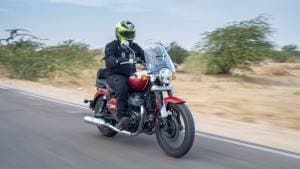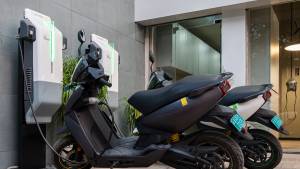Royal Enfield Interceptor 650 vs Benelli Leoncino 500
Royal Enfield shook up the sub-5 lakh rupee motorcycle market with its 650cc twins, particularly the Interceptor 650. The space that was revolutionised by the Harley-Davidson Street 750 originally, but at roughly half the Harley's price, the Interceptor 650 has turned out to be a stunning package. Its build quality, engine refinement, performance, handling and of course the simple yet gorgeous design have all contributed to making the Interceptor an irresistible proposition. Heck, it is also the current winner of the prestigious Indian Motorcycle of the Year award!
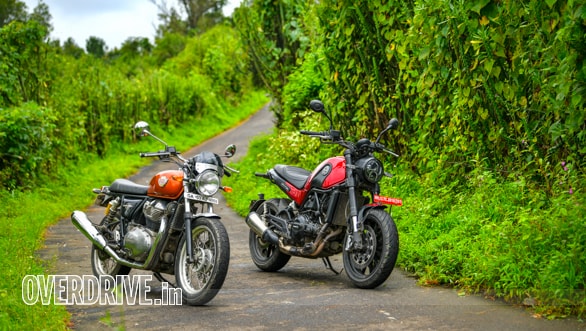 The Royal Enfield Interceptor 650 and Benelli Leoncino 500 are both very interesting propositions in the middleweight retro motorcycle space in India today, given what both motorcycles have to offer
The Royal Enfield Interceptor 650 and Benelli Leoncino 500 are both very interesting propositions in the middleweight retro motorcycle space in India today, given what both motorcycles have to offer
But now Benelli has entered the very space with the Leoncino 500. The bike is positioned as a retro motorcycle just like the Interceptor and boasts of an impressive equipment list. But the Leoncino also commands a significant premium over the Interceptor and that's besides the fact that Benelli does not really have a storied past in the country, unlike Royal Enfield. How does the Leoncino 500 fare against the Interceptor in the real world though? We took both motorcycles for a ride to find out.
Design and engineering
The first thing you notice is how different both motorcycles' design languages are, despite both being pegged as retro motorcycles. The Interceptor 650 is a true classic, while the Leoncino looks more modern. The Interceptor's beauty lies in its simplicity, whereas the Leoncino tries to look stylish, but the overall design is a bit of a mishmash as it appears like a mix between a Scrambler and streetbike. The Leoncino's headlamp unit uses the classic round shape and is an all-LED unit including a projector beam and daytime running lamps, but the design could have been better.
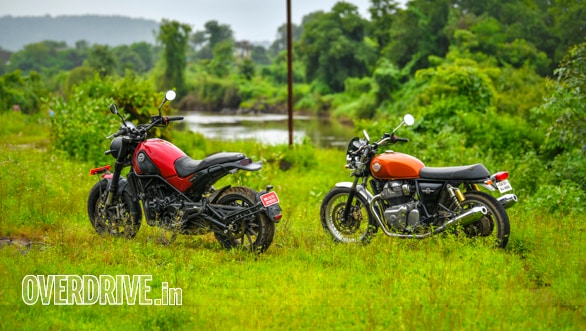 Given the differences between the design languages, the Royal Enfield Interceptor 650 and Benelli Leoncino 500 both look very different from each other despite their similar positioning
Given the differences between the design languages, the Royal Enfield Interceptor 650 and Benelli Leoncino 500 both look very different from each other despite their similar positioning
I do like the little Lion on the front mudguard as it has been designed tastefully, but unfortunately, the front number plate on out test bike hid the little beast. The beefy forks and 120-section front tyre on the Leoncino also give it a more muscular appearance. The Interceptor's front is a proper retro design in comparison with old school dispersion style headlamp unit replete with a chrome bezel and rectangular turn indicators, while the Leoncino gets slim LED indicators. The Interceptor uses a classic, twin-pod instrument cluster that's in line with its retro-cool quotient and looks good. The Leoncino uses a full-digital display that offers a lot more information though the display could have been better.
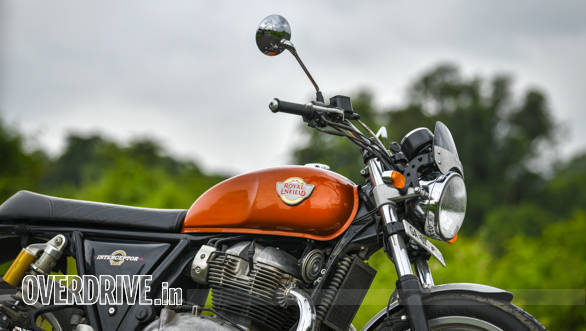 The Royal Enfield Interceptor 650's headlight and fuel tank use a design that's timeless and very appealing too. The flat seat following the fuel tank is another classic design element that adds to its stance
The Royal Enfield Interceptor 650's headlight and fuel tank use a design that's timeless and very appealing too. The flat seat following the fuel tank is another classic design element that adds to its stance
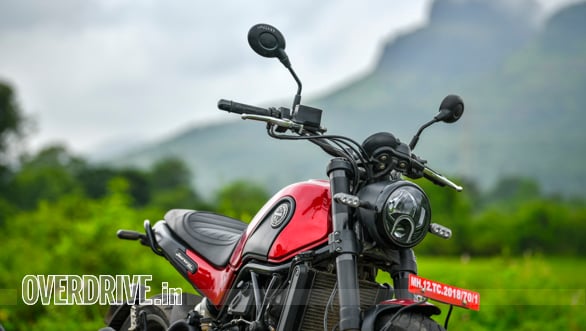 The Benelli Leoncino 500's headlight mixes modern elements like LED lighting to the classic round shape. The fuel tank design is not as appealing as the Interceptor's while the scooped seat makes for a more modern appearance
The Benelli Leoncino 500's headlight mixes modern elements like LED lighting to the classic round shape. The fuel tank design is not as appealing as the Interceptor's while the scooped seat makes for a more modern appearance
The Interceptor's fuel tank also appeals better despite being a simpler design and is followed by a flat seat, while the Leoncino's saddle is a scooped unit and rakes up towards the rear. The Leoncino's tail piece looks appealing with its integrated LED stop light but the Interceptor's derriere looks equally appealing if not more despite its simple design. A distinct highlight on the Interceptor are the chrome finished twin exhausts and wire-spoked wheels and the Interceptor thus scores better on the design front. In fact, while opinions in the office were divided about the Leoncino's looks, the Interceptor was unanimously voted as more appealing looking. Royal Enfield has also upped its quality game and the Interceptor leaves no doubts about it being a global product with its fit-finish and quality levels. To its credit, the Leoncino also feels a lot better built than some of the Benellis we have ridden in the past and is a significant improvement, but quality of plastics and fitment of panels could have been better.
Engines and performance
The Interceptor has made quite an impression despite using a very simple powertrain. The 650cc parallel-twin motor looks properly retro, especially with its surface finishes and design, besides impressing in heaps with its performance and refinement. On the other hand the Leoncino's powertrain is equally impressive if not better on several fronts. It has a few similarities to the Interceptor's powertrain, in the sense that it is a parallel-twin engine mated to a six-speed transmission and both bikes offer 47PS, but there's a few significant differences too.
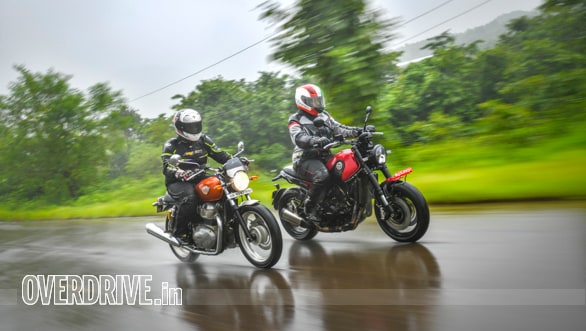 The Royal Enfield Interceptor 650 is the heavier of the two motorcycles but it's engine offers a more linear power delivery unlike the Leoncino 500's liquid-cooled motor which feels more high strung and also has a peakier power delivery in comparison
The Royal Enfield Interceptor 650 is the heavier of the two motorcycles but it's engine offers a more linear power delivery unlike the Leoncino 500's liquid-cooled motor which feels more high strung and also has a peakier power delivery in comparison
The Interceptor's motor is oil-cooled and offers 53Nm as opposed to the Leoncino's liquid-cooled motor that produces 46Nm. The Leoncino's engine is higher strung than the Interceptor's, as the Royal Enfield produces its peak power and torque at lower revs, besides putting its power down in a more linear manner. The Leoncino's peakier delivery means you need to rev it harder, though the motorcycle does reward with likeable performance when you do so. The Interceptor is also the lighter motorcycle and unsurprisingly, was the quicker of the two. The Royal Enfield clocked a 0-100kmph time of 6.28 seconds in our tests while the Benelli clocked 6.8 seconds.
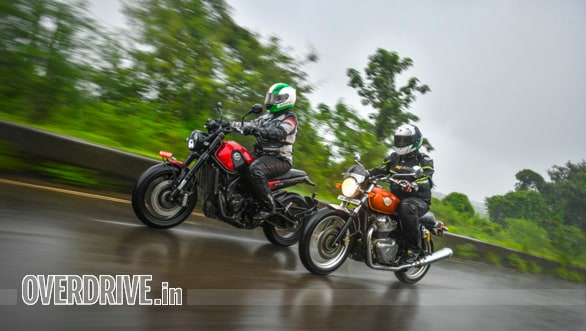 Given the stick, the Royal Enfield Interceptor 650 and Benelli Leoncino 500 both impress with their performance on open roads as both motorcycles can breach the 160kmph mark without feeling too stressed
Given the stick, the Royal Enfield Interceptor 650 and Benelli Leoncino 500 both impress with their performance on open roads as both motorcycles can breach the 160kmph mark without feeling too stressed
The Interceptor also feels quicker accelerating through the gears thanks to its flatter torque curve. Both motorcycles are equally adept at sustaining triple digit speeds and both can cruise at 120kmph without breaking a sweat. And both can also breach the 160kmph mark with ease and in that sense, both impress equally. That said, the Leoncino engine feels like it is working harder to deliver the goods as compared to the Interceptor's mill which feels relatively calmer and effortless. On another note, the two motorcycles also sound very different. The Interceptor has the classic British twin exhaust note and sounds really good, while the Leoncino tries to mimic an inline four cylinder engine and sounds good too.
Ride and handling
There's some serious differences between the two bikes in this department. Benelli is known to over-spec its motorcycles and the Leoncino 500 follows the tradition with its 50mm, upside-down front forks (with rebound adjustment) that's the stuff you see on motorcycles like the Ducati Diavel! At the rear the Benelli is suspended on a monoshock which gets a remote knob for adjusting preload directly, along with rebound adjustability. In comparison the Interceptor uses a set of 41mm, right-side up forks at the front which are non-adjustable. At the rear, the Interceptor is equipped with a set of gas-charged twin shock absorbers that offer preload adjustment. Clearly the Leoncino 500 has the better equipment then. That said both motorcycles offer a likeable mix between ride and handling, though the Leoncino obviously has an edge in terms of handling. The Benelli feels more planted around fast corners thanks to its superior suspension setup and also the Pirelli Angel ST tyres it is shod with, which together afford higher confidence levels even in pouring rain. The Leoncino also feels more stable at high speeds, albeit by just a small margin. The Interceptor's suspension offers ample confidence too but the bike is somewhat held back by its Pirelli Phantom Sportscomp tyres. These are tyres developed specifically for retro motorcycles and work well in most conditions, but fall short by a wee bit as compared to the Angel STs, especially on wet roads.
 The Benelli Leoncino 500 has the upper hand in the handling department thanks to its higher-specced components like the 50mm upside down forks and adjustable rear monoshock as compared to the Royal Enfield Interceptor 650's right side up forks and gas charged twin shock absorbers. The Benelli also boasts better braking prowess courtesy its twin 320mm discs upfront as compared to the Royal Enfield's single 320mm front disc
The Benelli Leoncino 500 has the upper hand in the handling department thanks to its higher-specced components like the 50mm upside down forks and adjustable rear monoshock as compared to the Royal Enfield Interceptor 650's right side up forks and gas charged twin shock absorbers. The Benelli also boasts better braking prowess courtesy its twin 320mm discs upfront as compared to the Royal Enfield's single 320mm front disc
The Interceptor claws back advantage with its better ride quality and has the ability to make almost all undulations disappear. It also feels better when tackling ruts, potholes and broken roads overall as its suspension setup is well balanced. In comparison, the Leoncino's front forks absorbs shocks well, but at stock settings the rear monoshock feels stiffer and transmits some shocks to the rider. Another advantage for the Interceptor are its wire-spoked wheels and simpler forks that let you go faster on bad roads as compared to the Leoncino's upside down forks and alloy wheels which require you to exercise more caution to avoid damage.
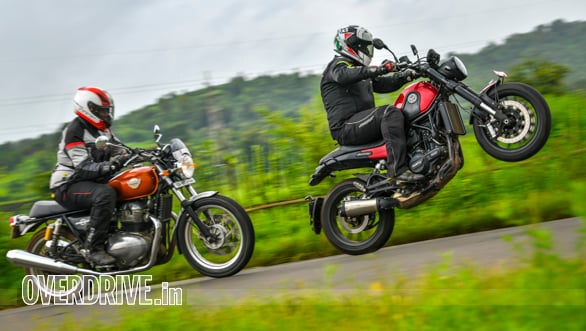 The Benelli Leoncino 500 feels like the more playful motorcycle of the two, but the Royal Enfield Interceptor 650 is up there with it at all times
The Benelli Leoncino 500 feels like the more playful motorcycle of the two, but the Royal Enfield Interceptor 650 is up there with it at all times
Then there's the brakes. The Leoncino is equipped with twin 320mm discs at the front that's again superbike-level equipment! The Interceptor uses a single 320mm disc which offers adequate braking prowess. The Leoncino of course offers sharper braking and also gets a dedicated switch to turn ABS off. On the whole the Leoncino is the sportier handler courtesy its higher-specced components but loses out to the Interceptor in terms of ride quality by a noticeable margin. There's a difference between the seating positions as well, as the Interceptor requires you to lean forward slightly, while the Leoncino's wider, taller handlebar has you sit upright and offers better leverage. That said, the Leoncino's larger turning radius can be a bit of an issue when making tight U-turns.
Verdict
Both motorcycles impress on various fronts and in fact, the Leoncino 500 comes across as a pleasant surprise with its sporty dynamics, courtesy its more elaborate equipment list. But on the flip side the higher-specced components are one reason behind the higher price tag. Also, the Leoncino is only assembled in India unlike the Interceptor 650 that's manufactured in Chennai. The Interceptor project actually began with the very brief that the bike had to be priced where it has been, though the motorcycle belies the ultra-affordable price tag with its brilliant packaging. In fact, before the Interceptor's launch, a price tag of Rs 3.11 lakh on road in Mumbai for a motorcycle powered by a 650cc twin could have been taken as a joke.
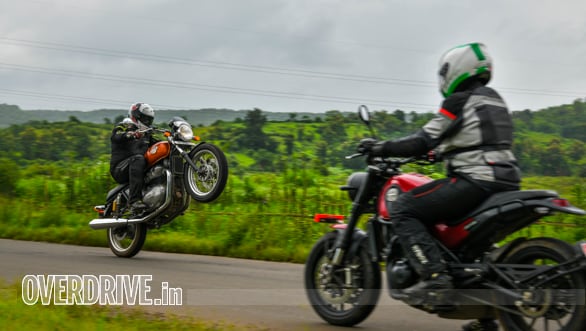 The Royal Enfield Interceptor 650's packaging is hard to beat for the Benelli Leoncino 500, especially at the former's price point, which sounds almost unreal for a 650cc, twin cylinder engine equipped motorcycle
The Royal Enfield Interceptor 650's packaging is hard to beat for the Benelli Leoncino 500, especially at the former's price point, which sounds almost unreal for a 650cc, twin cylinder engine equipped motorcycle
In comparison the Leoncino retails at Rs 5.87 lakh on road which is almost twice as much. The Benelli impresses on its own, betters the Interceptor on the handling front and is also a big improvement over Benelli's older products but it feels overpriced, especially in comparison to the Interceptor. The Royal Enfield does everything the Benelli does with aplomb while looking cooler and helping you save significant amounts of money. And it is the packaging and impressive road manners, coupled to that highly accessible price tag that make the Interceptor one of the best sub-5 lakh rupee motorcycles today and also the winner of this comparison test.
Also see: Benelli Leoncino 500 vs Royal Enfield Interceptor 650 video review
Starts Rs 2,56,372
648cc
6-Speed
47.00
52.00
-NA-

